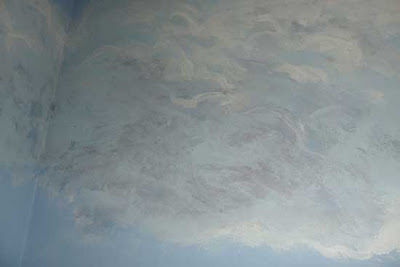In his book The Tell-Tale Brain: A Neuroscientist's Quest for What Makes Us Human the neuroscientist V.S. Ramachandran looks at aesthetics
from a scientist's viewpoint. He names what he calls his nine laws of aesthetics.
Some of them are intuitively known by artists or form part of the art training
that artists receive. Others are interesting to think about.
the neuroscientist V.S. Ramachandran looks at aesthetics
from a scientist's viewpoint. He names what he calls his nine laws of aesthetics.
Some of them are intuitively known by artists or form part of the art training
that artists receive. Others are interesting to think about.
Ramachandran does not hesitate to speculate about the
evolution of the laws of aesthetics, and he says so. After all, this is how
science progress. Someone throws an idea in the arena and others work on it,
either to confirm it or rebuke it.
1. Grouping
This is the fundamental idea that “a visual system tends to
group similar elements or features in the image into clusters.”
Ramachandran explains that the principle of grouping evolved
to defeat camouflage. The example he gives is the lion hidden behind foliage.
There is a clear survival advantage if our brain can put together the disparate
yellow splotches of the lion’s body behind the green splotches of the leaves.
Under the principle of grouping, another idea is that”
graphic elements suggesting a continued visual contour will tend to be grouped
together”.
2. Peak shift
The Law of Peak Shift My relates to how your brain responds
to exaggerated stimuli.
This principle explains why we like caricatures. But Ramachandran
also invite us to consider that principle make us appreciate works by Van Gogh,
Rodin, Gustav Klimt, Henry Moore, or Picasso.
On the neuroscience side, this is probably achieved “by the
deliberate exaggeration of posture that may activate—indeed hyper activate—mirror
neurons in the superior temporal sulcus.”
Follow some fascinating explanations of experiments on animal
behaviour carried out on seagulls by the Nobel Prize–winning biologist Nikolaas
Tinbergen. The gull chick pecks on the red spot on its mother’s beak to get food
by. Tinbergen used a rectangle with a red spot as a substitute. Tinbergen found
that the chick became hyperactive when it was presented with a very long thick
stick with three red stripes on the end.
3. Contrast
This one is quite obvious because without contrast,
there is no form.
4. Isolation
The “law of isolation” Is when “the artist emphasizes a
single source of information—such as colour, form, or motion—and deliberately
plays down or deletes other sources.”
Ramachandran believe that sketches are very effective
because cells in your primary visual cortex, where the earliest stage of visual
processing occurs, only care about lines. Sketches also pass the “attentional
bottleneck in your brain”.
5. Peekaboo, or
perceptual problem solving
This principle is based on the fact that “you can sometimes
make something more attractive by making it less visible.”
This one is easy to understand intuitively. We all
experienced the satisfaction of finding out a visual illusion in one of Dali’s
paintings for instance.
Ramachandran explains that it starts with the way we see: “When
you look at a simple visual scene, your brain is constantly resolving
ambiguities, testing hypotheses, searching for patterns, and comparing current
information with memories and expectations.”
6. Abhorrence of
coincidences
This one is interesting. An illustration of this is that we
don’t like a painting when a tree is exactly in the middle. What are the
chances of that happening?
7. Orderliness
Here, Ramachandran put together under this heading our abhorrence
for deviation from expectations. For the artist it is a matter of balance
between too much order (boring) and total chaos (not pleasing).
8. Symmetry
Ramachandran suggests that one explanation comes from…parasites:
“Parasitic infestation can profoundly reduce the fertility and fecundity of a
potential mate, so evolution places a very high premium on being able to detect
whether your mate is infected. If the infestation occurred in early fetal life
or infancy, one of the most obvious externally visible signs is a subtle loss
of symmetry. Therefore, symmetry is a marker, or flag, for good health, which
in turn is an indicator of desirability.”
The author then tackles the question apparent paradox that a
lack of symmetry may also be appealing at times. His answer is that “the
symmetry rule applies only to objects, not to large-scale scenes.”
9. Metaphors
Metaphors used
extensively in visual art. Ramachandran
expresses is fascination for the fact that a “visual metaphor is probably
understood by the right hemisphere long before the more literal-minded left
hemisphere can spell out the reasons.”
Even if the author does not make the express link, I think
that the Peekaboo, or perceptual problem solving principle plays a role in our
appreciation of metaphor. A metaphor is a kind of puzzle and our brain must take
pleasure in resolving these riddles.
In conclusion, Ramachandran explains that these principles in
a single work can enhance each other. This is what he calls “resonance”.
Even if the part on art is only one chapter, I would
recommend that you read this book. It is one of the most interesting reads
around and Ramachandran has a gift to explain in simple words some very complex
pieces of research. This is the work of a true humanist, looking at so many
aspects of our world through his neuroscientist experience.
Related resources
Get the book from Amazon in the US (Associate program link)
Get the book from Amazon in the UK (Associate program link)




































.jpg.opt646x906o0,0s646x906+(1).jpg)



